Linear Algebra (Math-244) Homework 1: Matrix Problems and Solutions
VerifiedAdded on 2022/09/12
|8
|685
|19
Homework Assignment
AI Summary
This document presents solutions to a Linear Algebra homework assignment, addressing problems related to matrix operations and linear algebra concepts. The solutions include finding values for matrix equations, calculating the adjoint and inverse of a matrix, demonstrating row equivalence between matrices, and determining the values for which a system of linear equations has unique, infinite, or no solutions. Furthermore, it explores vector subspaces, including finding bases and dimensions, and proves properties related to these subspaces. The solutions are detailed and demonstrate the application of linear algebra principles to solve the given problems. References to relevant linear algebra resources are also provided.
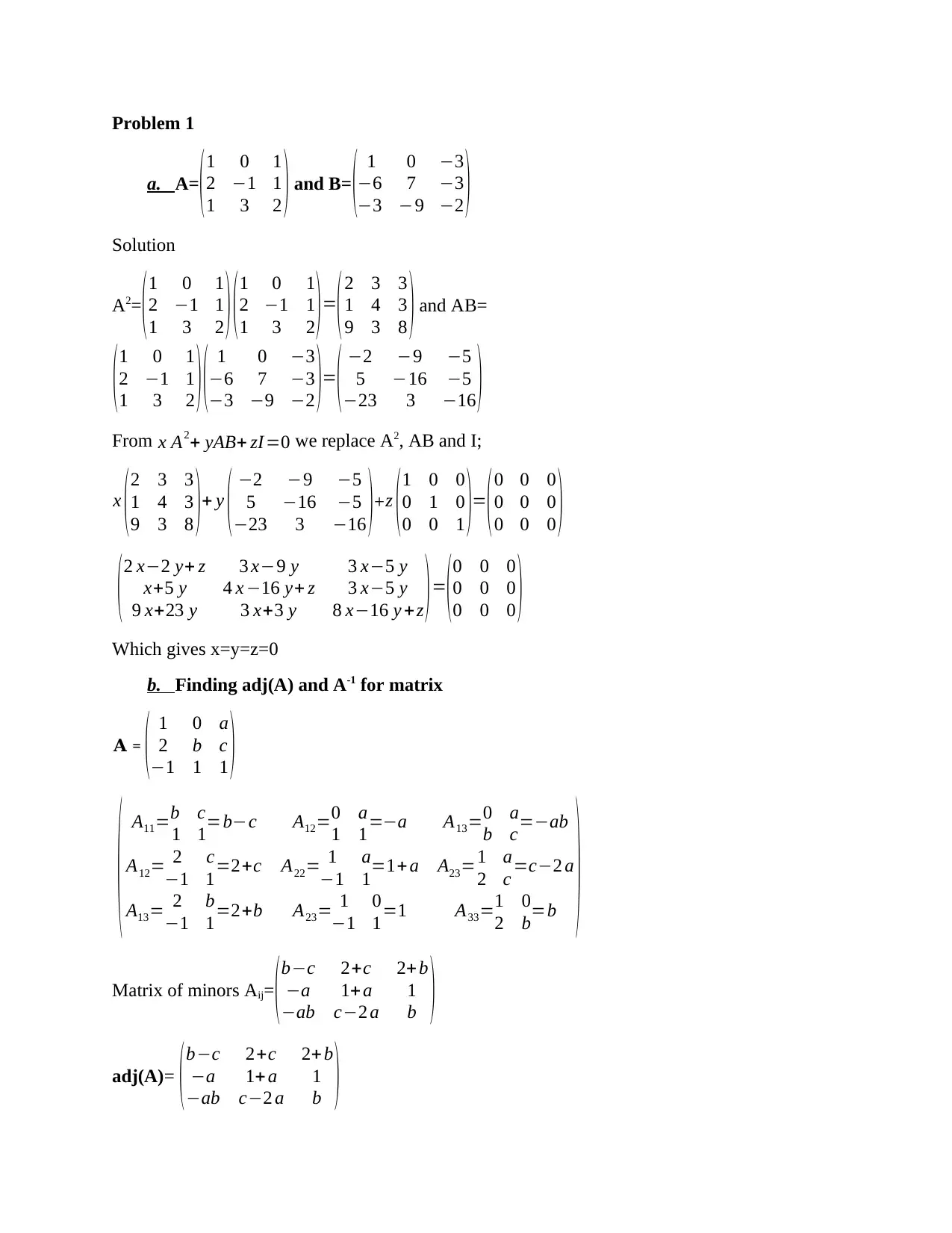
Problem 1
a. A=
(1 0 1
2 −1 1
1 3 2 ) and B=
( 1 0 −3
−6 7 −3
−3 −9 −2 )
Solution
A2=
(1 0 1
2 −1 1
1 3 2 )(1 0 1
2 −1 1
1 3 2)=
(2 3 3
1 4 3
9 3 8 ) and AB=
(1 0 1
2 −1 1
1 3 2 )( 1 0 −3
−6 7 −3
−3 −9 −2 )=
( −2 −9 −5
5 −16 −5
−23 3 −16 )
From x A2+ yAB+ zI=0 we replace A2, AB and I;
x (2 3 3
1 4 3
9 3 8 )+ y ( −2 −9 −5
5 −16 −5
−23 3 −16 )+z (1 0 0
0 1 0
0 0 1 )=
(0 0 0
0 0 0
0 0 0 )
( 2 x−2 y+ z 3 x−9 y 3 x−5 y
x+5 y 4 x −16 y+ z 3 x−5 y
9 x+23 y 3 x+3 y 8 x−16 y +z ) =
( 0 0 0
0 0 0
0 0 0 )
Which gives x=y=z=0
b. Finding adj(A) and A-1 for matrix
𝐀 = ( 1 0 a
2 b c
−1 1 1 )
( A11=b c
1 1=b−c A12=0 a
1 1=−a A13=0 a
b c=−ab
A12= 2 c
−1 1=2+c A22= 1 a
−1 1=1+ a A23=1 a
2 c =c−2 a
A13= 2 b
−1 1=2+b A23= 1 0
−1 1=1 A33=1 0
2 b=b )
Matrix of minors Aij=
(b−c 2+c 2+ b
−a 1+ a 1
−ab c−2 a b )
adj(A)= ( b−c 2+c 2+b
−a 1+ a 1
−ab c−2 a b )
a. A=
(1 0 1
2 −1 1
1 3 2 ) and B=
( 1 0 −3
−6 7 −3
−3 −9 −2 )
Solution
A2=
(1 0 1
2 −1 1
1 3 2 )(1 0 1
2 −1 1
1 3 2)=
(2 3 3
1 4 3
9 3 8 ) and AB=
(1 0 1
2 −1 1
1 3 2 )( 1 0 −3
−6 7 −3
−3 −9 −2 )=
( −2 −9 −5
5 −16 −5
−23 3 −16 )
From x A2+ yAB+ zI=0 we replace A2, AB and I;
x (2 3 3
1 4 3
9 3 8 )+ y ( −2 −9 −5
5 −16 −5
−23 3 −16 )+z (1 0 0
0 1 0
0 0 1 )=
(0 0 0
0 0 0
0 0 0 )
( 2 x−2 y+ z 3 x−9 y 3 x−5 y
x+5 y 4 x −16 y+ z 3 x−5 y
9 x+23 y 3 x+3 y 8 x−16 y +z ) =
( 0 0 0
0 0 0
0 0 0 )
Which gives x=y=z=0
b. Finding adj(A) and A-1 for matrix
𝐀 = ( 1 0 a
2 b c
−1 1 1 )
( A11=b c
1 1=b−c A12=0 a
1 1=−a A13=0 a
b c=−ab
A12= 2 c
−1 1=2+c A22= 1 a
−1 1=1+ a A23=1 a
2 c =c−2 a
A13= 2 b
−1 1=2+b A23= 1 0
−1 1=1 A33=1 0
2 b=b )
Matrix of minors Aij=
(b−c 2+c 2+ b
−a 1+ a 1
−ab c−2 a b )
adj(A)= ( b−c 2+c 2+b
−a 1+ a 1
−ab c−2 a b )
Paraphrase This Document
Need a fresh take? Get an instant paraphrase of this document with our AI Paraphraser
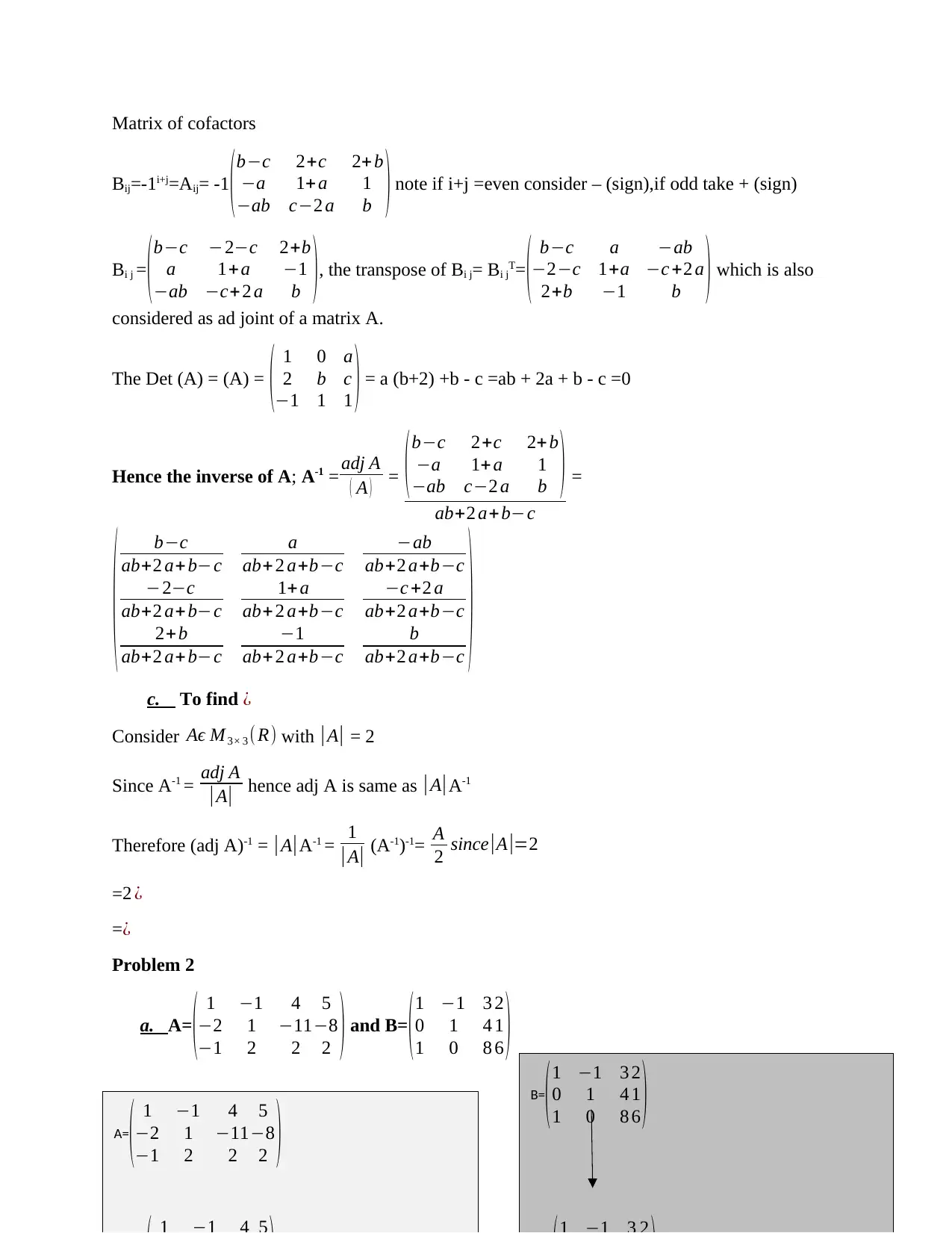
Matrix of cofactors
Bij=-1i+j=Aij= -1
(b−c 2+c 2+ b
−a 1+ a 1
−ab c−2 a b ) note if i+j =even consider – (sign),if odd take + (sign)
Bi j =
(b−c −2−c 2+b
a 1+ a −1
−ab −c+ 2 a b ), the transpose of Bi j= Bi jT=
( b−c a −ab
−2−c 1+a −c +2 a
2+b −1 b ) which is also
considered as ad joint of a matrix A.
The Det (A) = (A) = ( 1 0 a
2 b c
−1 1 1 ) = a (b+2) +b - c =ab + 2a + b - c =0
Hence the inverse of A; A-1 = adj A
( A ) = (b−c 2+c 2+ b
−a 1+ a 1
−ab c−2 a b )
ab+2 a+b−c
=
( b−c
ab+2 a+ b−c
a
ab+ 2 a+b−c
−ab
ab+2 a+b−c
−2−c
ab+2 a+ b−c
1+ a
ab+ 2 a+b−c
−c +2 a
ab+2 a+b−c
2+b
ab+2 a+ b−c
−1
ab+ 2 a+b−c
b
ab+2 a+b−c
)c. To find ¿
Consider Aϵ M 3× 3 ( R) with | A| = 2
Since A-1 = adj A
| A| hence adj A is same as |A|A-1
Therefore (adj A)-1 = |A|A-1 = 1
|A| (A-1)-1= A
2 since |A |=2
=2 ¿
=¿
Problem 2
a. A=
( 1 −1 4
−2 1 −11
−1 2 2
5
−8
2 ) and B=
( 1 −1 3
0 1 4
1 0 8
2
1
6 )
A=
( 1 −1 4
−2 1 −11
−1 2 2
5
−8
2 ) B=
(1 −1 3
0 1 4
1 0 8
2
1
6 )
Bij=-1i+j=Aij= -1
(b−c 2+c 2+ b
−a 1+ a 1
−ab c−2 a b ) note if i+j =even consider – (sign),if odd take + (sign)
Bi j =
(b−c −2−c 2+b
a 1+ a −1
−ab −c+ 2 a b ), the transpose of Bi j= Bi jT=
( b−c a −ab
−2−c 1+a −c +2 a
2+b −1 b ) which is also
considered as ad joint of a matrix A.
The Det (A) = (A) = ( 1 0 a
2 b c
−1 1 1 ) = a (b+2) +b - c =ab + 2a + b - c =0
Hence the inverse of A; A-1 = adj A
( A ) = (b−c 2+c 2+ b
−a 1+ a 1
−ab c−2 a b )
ab+2 a+b−c
=
( b−c
ab+2 a+ b−c
a
ab+ 2 a+b−c
−ab
ab+2 a+b−c
−2−c
ab+2 a+ b−c
1+ a
ab+ 2 a+b−c
−c +2 a
ab+2 a+b−c
2+b
ab+2 a+ b−c
−1
ab+ 2 a+b−c
b
ab+2 a+b−c
)c. To find ¿
Consider Aϵ M 3× 3 ( R) with | A| = 2
Since A-1 = adj A
| A| hence adj A is same as |A|A-1
Therefore (adj A)-1 = |A|A-1 = 1
|A| (A-1)-1= A
2 since |A |=2
=2 ¿
=¿
Problem 2
a. A=
( 1 −1 4
−2 1 −11
−1 2 2
5
−8
2 ) and B=
( 1 −1 3
0 1 4
1 0 8
2
1
6 )
A=
( 1 −1 4
−2 1 −11
−1 2 2
5
−8
2 ) B=
(1 −1 3
0 1 4
1 0 8
2
1
6 )
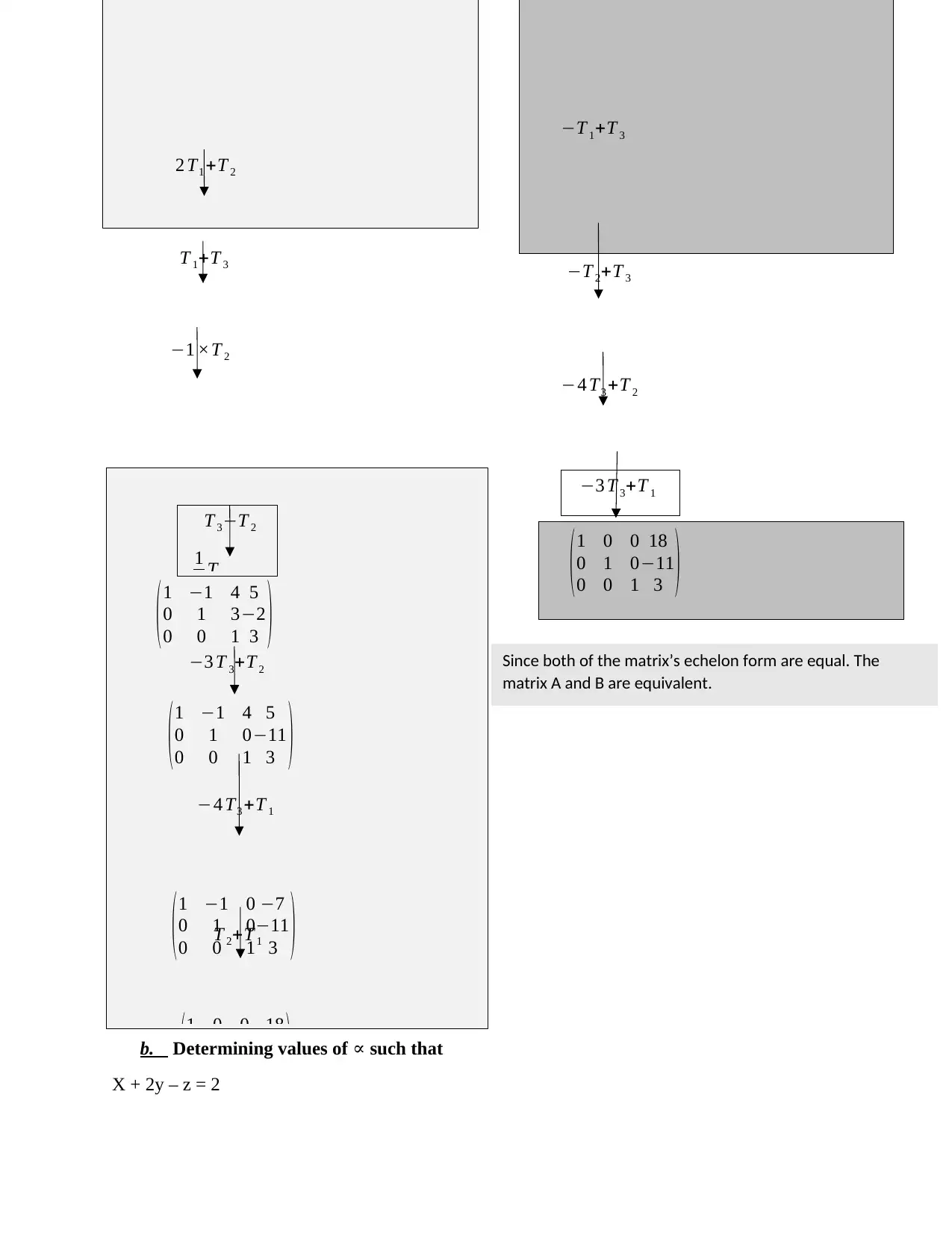
b. Determining values of ∝ such that
X + 2y – z = 2
( 0 −1 −3
−1 2 2
2
2 ) ( 0 1 4
0 1 5
1
4 )
2 T1 +T 2
(1 −1 4
0 1 3
0 0 1
5
−2
3 )
(1 −1 4
0 1 0
0 0 1
5
−11
3 )
(1 −1 0
0 1 0
0 0 1
−7
−11
3 )
(1 0 0
0 1 0
0 0 1
−18
−11
3 )
(1 0 0
0 1 0
0 0 1
18
−11
3 )
−T 1+T 3
−T 2+T 3
−4 T3 +T 2
−3 T 3+T 1
T 1+T 3
−1 ×T 2
T 3−T 2
1
3 T 3
−3 T 3+T 2
−4 T3 +T 1
T 2+T 1
Since both of the matrix’s echelon form are equal. The
matrix A and B are equivalent.
X + 2y – z = 2
( 0 −1 −3
−1 2 2
2
2 ) ( 0 1 4
0 1 5
1
4 )
2 T1 +T 2
(1 −1 4
0 1 3
0 0 1
5
−2
3 )
(1 −1 4
0 1 0
0 0 1
5
−11
3 )
(1 −1 0
0 1 0
0 0 1
−7
−11
3 )
(1 0 0
0 1 0
0 0 1
−18
−11
3 )
(1 0 0
0 1 0
0 0 1
18
−11
3 )
−T 1+T 3
−T 2+T 3
−4 T3 +T 2
−3 T 3+T 1
T 1+T 3
−1 ×T 2
T 3−T 2
1
3 T 3
−3 T 3+T 2
−4 T3 +T 1
T 2+T 1
Since both of the matrix’s echelon form are equal. The
matrix A and B are equivalent.
⊘ This is a preview!⊘
Do you want full access?
Subscribe today to unlock all pages.

Trusted by 1+ million students worldwide
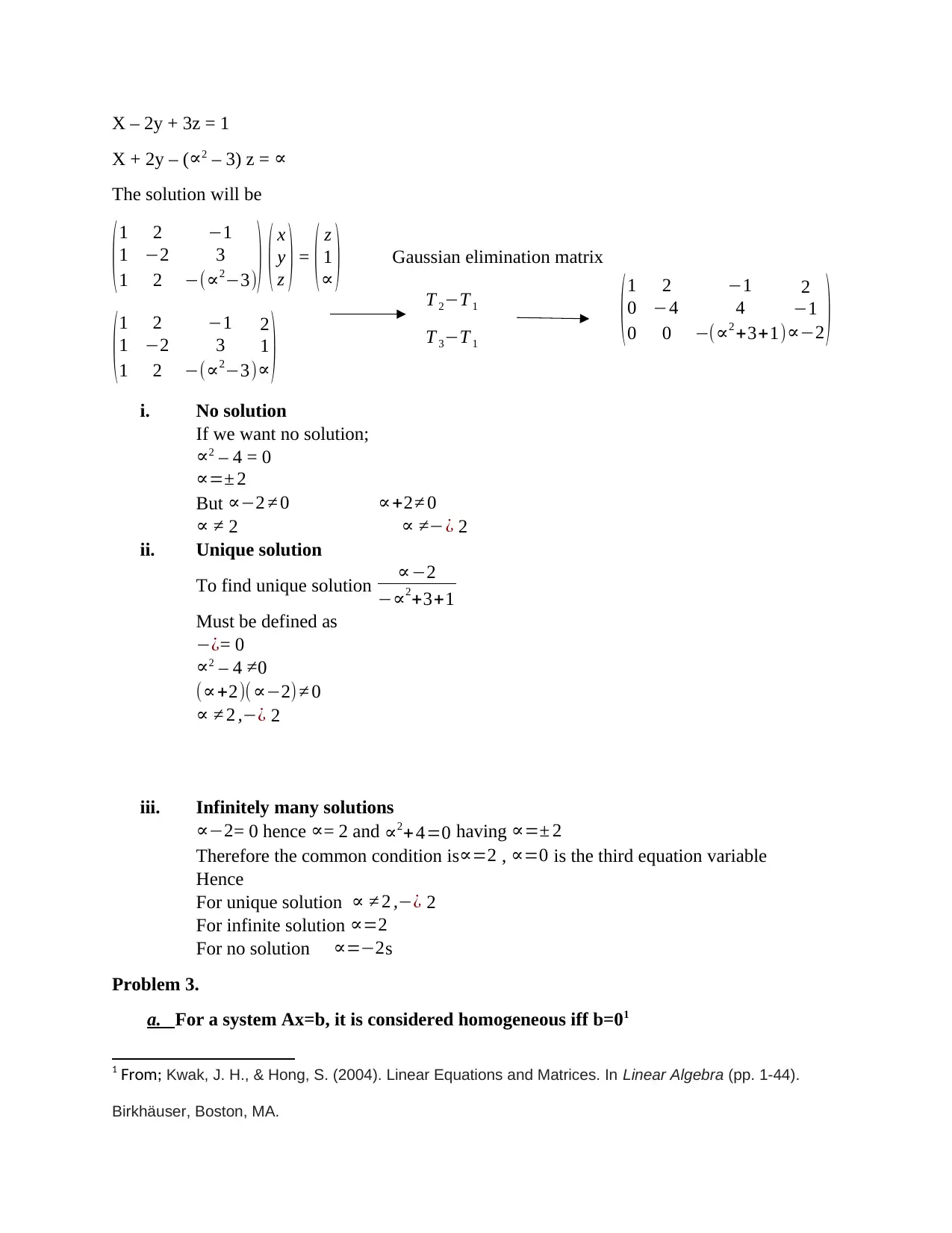
X – 2y + 3z = 1
X + 2y – (∝2 – 3) z = ∝
The solution will be
( 1 2 −1
1 −2 3
1 2 −(∝2−3)) ( x
y
z ) = ( z
1
∝ ) Gaussian elimination matrix
( 1 2 −1
1 −2 3
1 2 −(∝2−3)
2
1
∝ )
i. No solution
If we want no solution;
∝2 – 4 = 0
∝=± 2
But ∝−2 ≠ 0 ∝+2≠ 0
∝ ≠ 2 ∝ ≠−¿ 2
ii. Unique solution
To find unique solution ∝−2
−∝2+3+1
Must be defined as
−¿= 0
∝2 – 4 ≠0
(∝+2)( ∝−2)≠ 0
∝ ≠ 2 ,−¿ 2
iii. Infinitely many solutions
∝−2= 0 hence ∝= 2 and ∝2+ 4=0 having ∝=± 2
Therefore the common condition is∝=2 , ∝=0 is the third equation variable
Hence
For unique solution ∝ ≠ 2 ,−¿ 2
For infinite solution ∝=2
For no solution ∝=−2s
Problem 3.
a. For a system Ax=b, it is considered homogeneous iff b=01
1 From; Kwak, J. H., & Hong, S. (2004). Linear Equations and Matrices. In Linear Algebra (pp. 1-44).
Birkhäuser, Boston, MA.
T 2−T 1
T 3−T 1
( 1 2 −1
0 −4 4
0 0 −(∝2 +3+1)
2
−1
∝−2 )
X + 2y – (∝2 – 3) z = ∝
The solution will be
( 1 2 −1
1 −2 3
1 2 −(∝2−3)) ( x
y
z ) = ( z
1
∝ ) Gaussian elimination matrix
( 1 2 −1
1 −2 3
1 2 −(∝2−3)
2
1
∝ )
i. No solution
If we want no solution;
∝2 – 4 = 0
∝=± 2
But ∝−2 ≠ 0 ∝+2≠ 0
∝ ≠ 2 ∝ ≠−¿ 2
ii. Unique solution
To find unique solution ∝−2
−∝2+3+1
Must be defined as
−¿= 0
∝2 – 4 ≠0
(∝+2)( ∝−2)≠ 0
∝ ≠ 2 ,−¿ 2
iii. Infinitely many solutions
∝−2= 0 hence ∝= 2 and ∝2+ 4=0 having ∝=± 2
Therefore the common condition is∝=2 , ∝=0 is the third equation variable
Hence
For unique solution ∝ ≠ 2 ,−¿ 2
For infinite solution ∝=2
For no solution ∝=−2s
Problem 3.
a. For a system Ax=b, it is considered homogeneous iff b=01
1 From; Kwak, J. H., & Hong, S. (2004). Linear Equations and Matrices. In Linear Algebra (pp. 1-44).
Birkhäuser, Boston, MA.
T 2−T 1
T 3−T 1
( 1 2 −1
0 −4 4
0 0 −(∝2 +3+1)
2
−1
∝−2 )
Paraphrase This Document
Need a fresh take? Get an instant paraphrase of this document with our AI Paraphraser
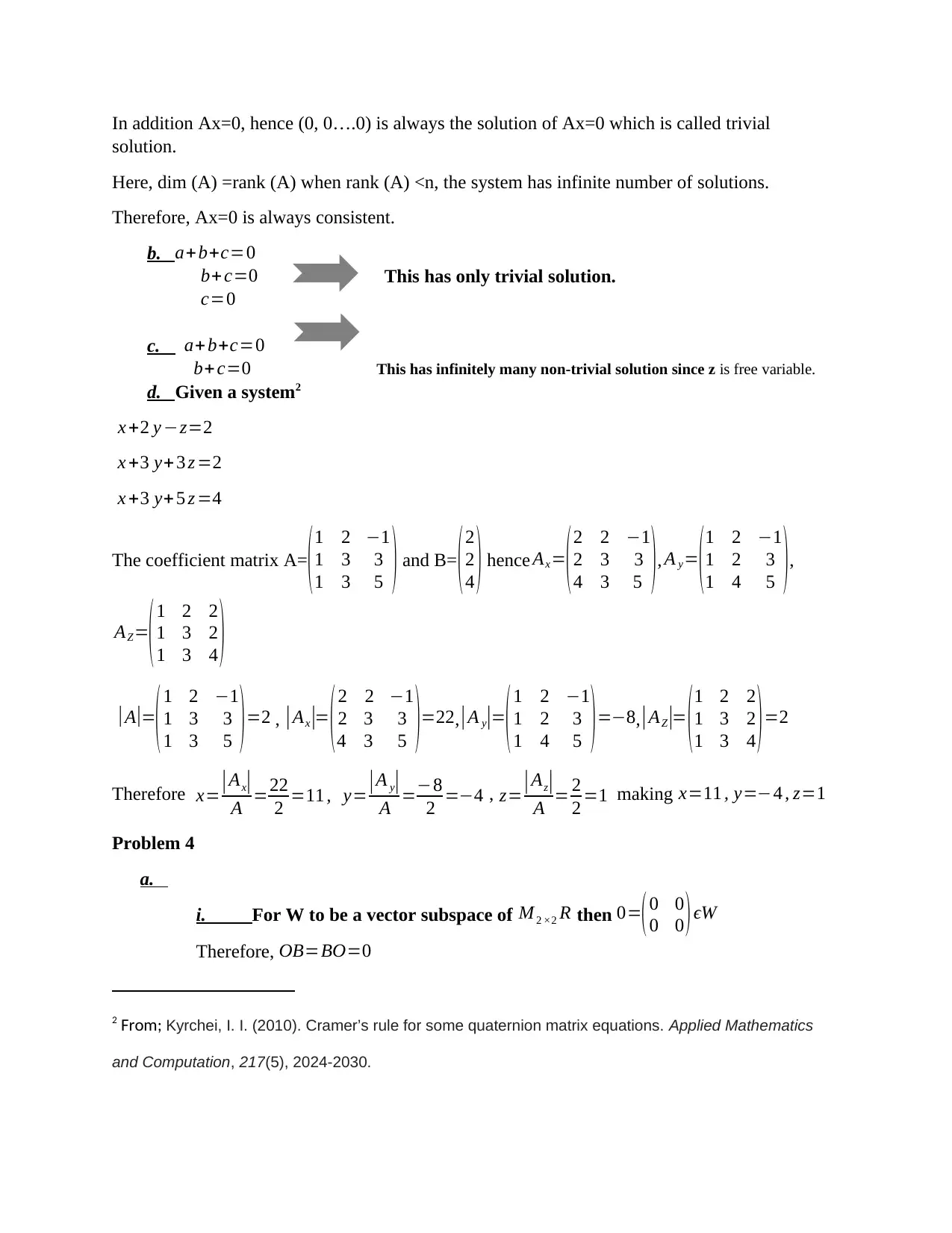
In addition Ax=0, hence (0, 0….0) is always the solution of Ax=0 which is called trivial
solution.
Here, dim (A) =rank (A) when rank (A) <n, the system has infinite number of solutions.
Therefore, Ax=0 is always consistent.
b. a+b+c=0
b+c=0 This has only trivial solution.
c=0
c. a+ b+c=0
b+ c=0 This has infinitely many non-trivial solution since z is free variable.
d. Given a system2
x +2 y −z=2
x +3 y+ 3 z =2
x +3 y+5 z =4
The coefficient matrix A=
(1 2 −1
1 3 3
1 3 5 ) and B=
(2
2
4 ) hence Ax=
(2 2 −1
2 3 3
4 3 5 ), A y=
(1 2 −1
1 2 3
1 4 5 ),
AZ=
(1 2 2
1 3 2
1 3 4 )
|A|=
(1 2 −1
1 3 3
1 3 5 )=2 , |Ax|= (2 2 −1
2 3 3
4 3 5 )=22,|A y|=
(1 2 −1
1 2 3
1 4 5 )=−8,|AZ|= (1 2 2
1 3 2
1 3 4 )=2
Therefore x= | Ax|
A =22
2 =11 , y= | A y|
A =−8
2 =−4 , z= | Az|
A = 2
2 =1 making x=11 , y=−4 , z=1
Problem 4
a.
i. For W to be a vector subspace of M 2 ×2 R then 0=(0 0
0 0 )ϵW
Therefore, OB=BO=0
2 From; Kyrchei, I. I. (2010). Cramer’s rule for some quaternion matrix equations. Applied Mathematics
and Computation, 217(5), 2024-2030.
solution.
Here, dim (A) =rank (A) when rank (A) <n, the system has infinite number of solutions.
Therefore, Ax=0 is always consistent.
b. a+b+c=0
b+c=0 This has only trivial solution.
c=0
c. a+ b+c=0
b+ c=0 This has infinitely many non-trivial solution since z is free variable.
d. Given a system2
x +2 y −z=2
x +3 y+ 3 z =2
x +3 y+5 z =4
The coefficient matrix A=
(1 2 −1
1 3 3
1 3 5 ) and B=
(2
2
4 ) hence Ax=
(2 2 −1
2 3 3
4 3 5 ), A y=
(1 2 −1
1 2 3
1 4 5 ),
AZ=
(1 2 2
1 3 2
1 3 4 )
|A|=
(1 2 −1
1 3 3
1 3 5 )=2 , |Ax|= (2 2 −1
2 3 3
4 3 5 )=22,|A y|=
(1 2 −1
1 2 3
1 4 5 )=−8,|AZ|= (1 2 2
1 3 2
1 3 4 )=2
Therefore x= | Ax|
A =22
2 =11 , y= | A y|
A =−8
2 =−4 , z= | Az|
A = 2
2 =1 making x=11 , y=−4 , z=1
Problem 4
a.
i. For W to be a vector subspace of M 2 ×2 R then 0=(0 0
0 0 )ϵW
Therefore, OB=BO=0
2 From; Kyrchei, I. I. (2010). Cramer’s rule for some quaternion matrix equations. Applied Mathematics
and Computation, 217(5), 2024-2030.
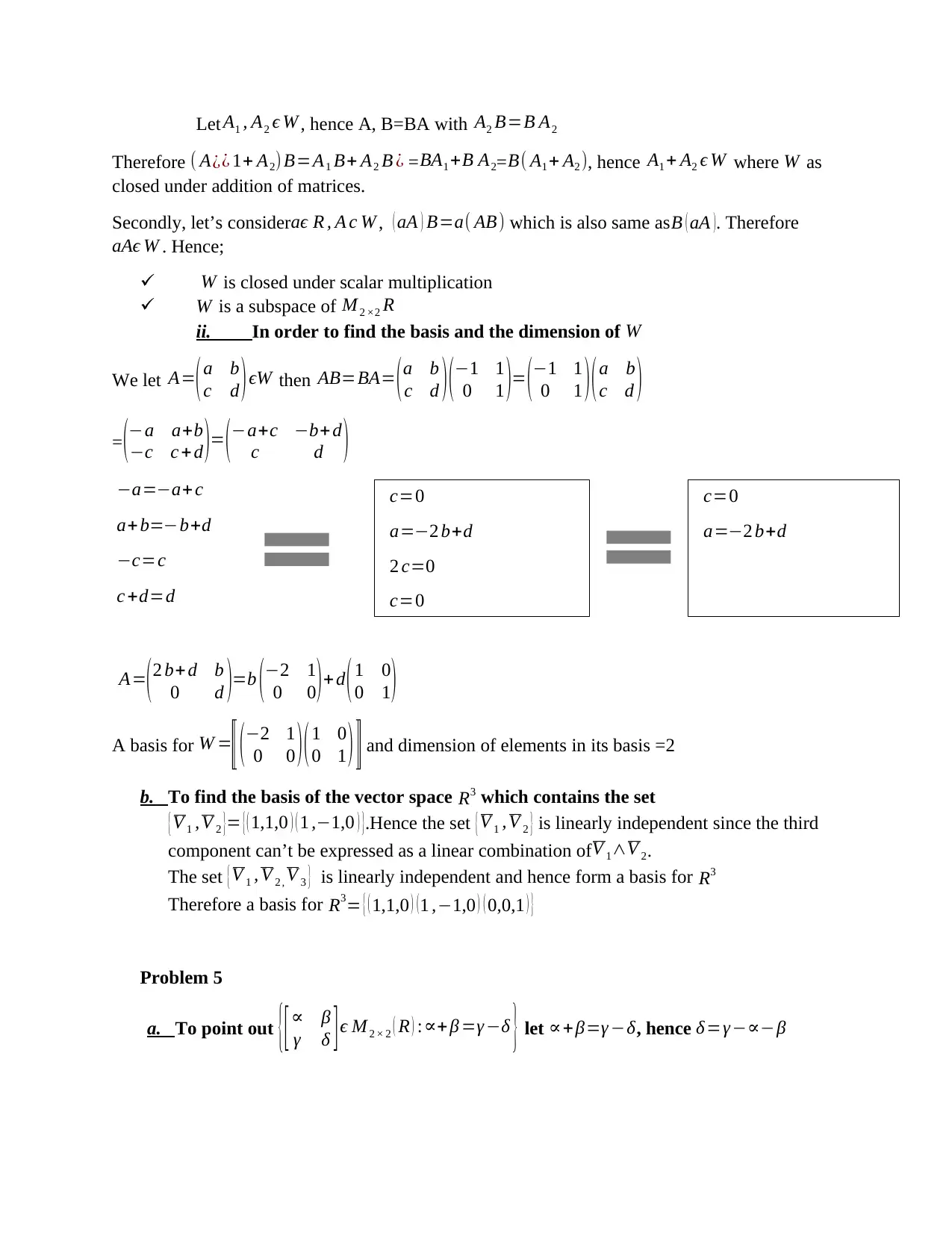
Let A1 , A2 ϵ W , hence A, B=BA with A2 B=B A2
Therefore ( A¿¿ 1+ A2) B=A1 B+ A2 B ¿ =BA1 +B A2= B( A1 + A2 ), hence A1 + A2 ϵ W where W as
closed under addition of matrices.
Secondly, let’s consider aϵ R , A c W , ( aA ) B=a( AB) which is also same as B ( aA ). Therefore
aAϵ W . Hence;
W is closed under scalar multiplication
W is a subspace of M 2 ×2 R
ii. In order to find the basis and the dimension of W
We let A=( a b
c d ) ϵW then AB=BA= ( a b
c d )(−1 1
0 1 )= (−1 1
0 1 )( a b
c d )
=(−a a+b
−c c + d )= (−a+c −b+ d
c d )
−a=−a+ c
a+b=−b+d
−c=c
c +d=d
A=( 2 b+ d b
0 d )=b (−2 1
0 0) +d ( 1 0
0 1)
A basis for W =
⟦ (−2 1
0 0 )( 1 0
0 1 ) ⟧ and dimension of elements in its basis =2
b. To find the basis of the vector space R3 which contains the set
{V 1 , V 2 }= {( 1,1,0 ) ( 1 ,−1,0 ) }.Hence the set {V 1 , V 2 } is linearly independent since the third
component can’t be expressed as a linear combination ofV 1∧V 2.
The set {V 1 , V 2 , V 3 } is linearly independent and hence form a basis for R3
Therefore a basis for R3= { ( 1,1,0 ) ( 1 ,−1,0 ) ( 0,0,1 ) }
Problem 5
a. To point out {[ ∝ β
γ δ ] ϵ M 2 × 2 ( R ) :∝+β =γ −δ } let ∝+β=γ −δ, hence δ=γ−∝−β
c=0
a=−2 b+d
2 c=0
c=0
c=0
a=−2 b+d
Therefore ( A¿¿ 1+ A2) B=A1 B+ A2 B ¿ =BA1 +B A2= B( A1 + A2 ), hence A1 + A2 ϵ W where W as
closed under addition of matrices.
Secondly, let’s consider aϵ R , A c W , ( aA ) B=a( AB) which is also same as B ( aA ). Therefore
aAϵ W . Hence;
W is closed under scalar multiplication
W is a subspace of M 2 ×2 R
ii. In order to find the basis and the dimension of W
We let A=( a b
c d ) ϵW then AB=BA= ( a b
c d )(−1 1
0 1 )= (−1 1
0 1 )( a b
c d )
=(−a a+b
−c c + d )= (−a+c −b+ d
c d )
−a=−a+ c
a+b=−b+d
−c=c
c +d=d
A=( 2 b+ d b
0 d )=b (−2 1
0 0) +d ( 1 0
0 1)
A basis for W =
⟦ (−2 1
0 0 )( 1 0
0 1 ) ⟧ and dimension of elements in its basis =2
b. To find the basis of the vector space R3 which contains the set
{V 1 , V 2 }= {( 1,1,0 ) ( 1 ,−1,0 ) }.Hence the set {V 1 , V 2 } is linearly independent since the third
component can’t be expressed as a linear combination ofV 1∧V 2.
The set {V 1 , V 2 , V 3 } is linearly independent and hence form a basis for R3
Therefore a basis for R3= { ( 1,1,0 ) ( 1 ,−1,0 ) ( 0,0,1 ) }
Problem 5
a. To point out {[ ∝ β
γ δ ] ϵ M 2 × 2 ( R ) :∝+β =γ −δ } let ∝+β=γ −δ, hence δ=γ−∝−β
c=0
a=−2 b+d
2 c=0
c=0
c=0
a=−2 b+d
⊘ This is a preview!⊘
Do you want full access?
Subscribe today to unlock all pages.

Trusted by 1+ million students worldwide
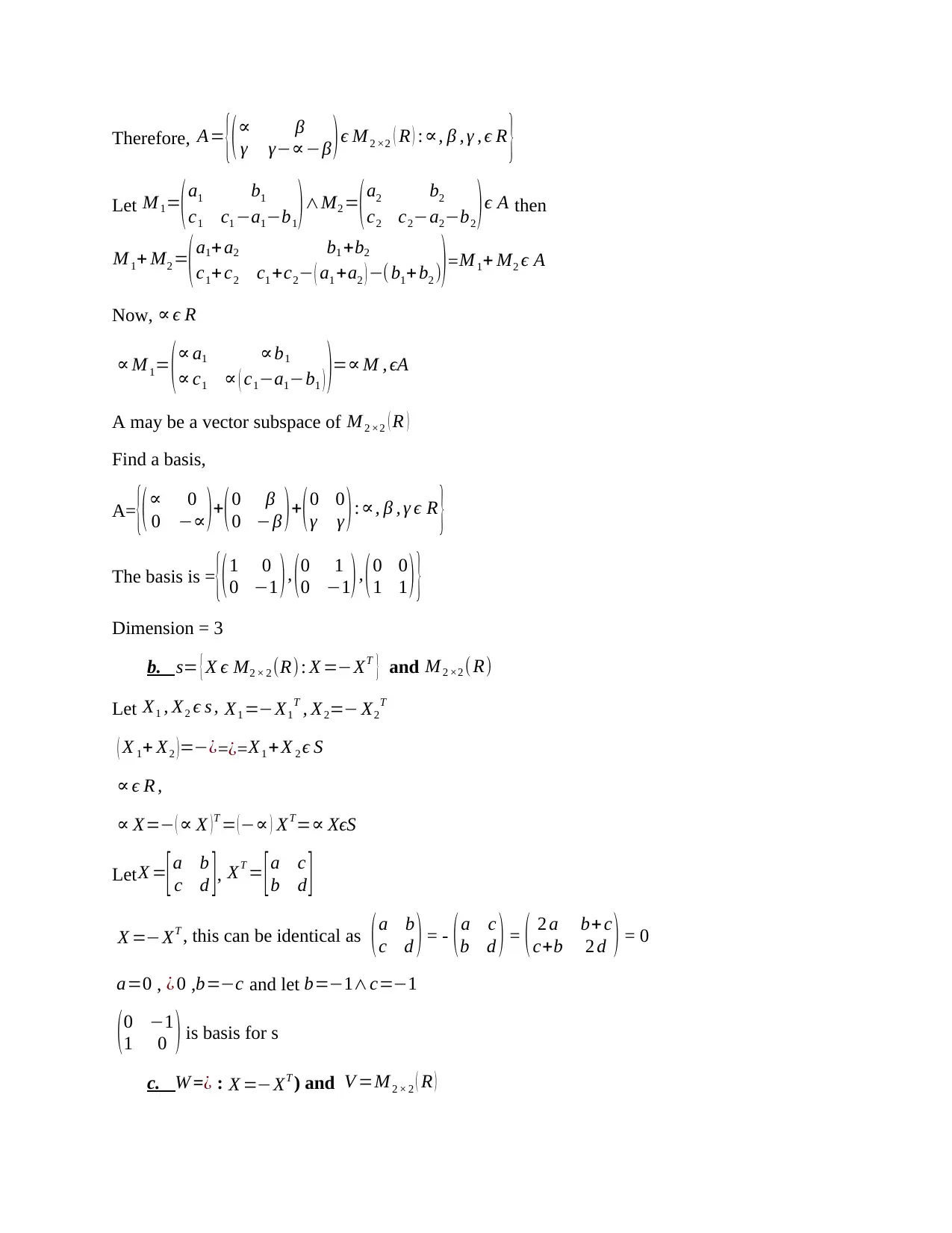
Therefore, A= {( ∝ β
γ γ−∝−β ) ϵ M 2 ×2 ( R ) :∝, β , γ , ϵ R }
Let M 1=
(a1 b1
c1 c1 −a1−b1 )∧M2 =
(a2 b2
c2 c2−a2−b2 )ϵ A then
M 1+ M2 =
( a1+a2 b1 +b2
c1+c2 c1 +c2− ( a1 +a2 ) −( b1+ b2 ))=M 1+ M2 ϵ A
Now, ∝ ϵ R
∝ M1= (∝ a1 ∝b1
∝ c1 ∝ ( c1−a1−b1 ) )=∝ M , ϵA
A may be a vector subspace of M 2 ×2 ( R )
Find a basis,
A= {( ∝ 0
0 −∝ ) +( 0 β
0 −β ) +( 0 0
γ γ ) :∝, β , γ ϵ R }
The basis is ={( 1 0
0 −1 ) , ( 0 1
0 −1) , ( 0 0
1 1 ) }
Dimension = 3
b. s= { X ϵ M2 × 2 (R) : X =−XT } and M 2 ×2 (R)
Let X1 , X2 ϵ s , X1 =−X1
T , X2=− X2
T
( X 1+ X2 ) =−¿=¿= X1 + X 2 ϵ S
∝ ϵ R ,
∝ X=− ( ∝ X ) T = ( −∝ ) XT=∝ XϵS
Let X =
[ a b
c d ], XT = [ a c
b d ]
X =−XT , this can be identical as ( a b
c d ) = - ( a c
b d ) = ( 2 a b+c
c+b 2 d ) = 0
a=0 , ¿ 0 ,b=−c and let b=−1∧c=−1
(0 −1
1 0 ) is basis for s
c. W =¿ : X =−XT ) and V =M 2 × 2 ( R )
γ γ−∝−β ) ϵ M 2 ×2 ( R ) :∝, β , γ , ϵ R }
Let M 1=
(a1 b1
c1 c1 −a1−b1 )∧M2 =
(a2 b2
c2 c2−a2−b2 )ϵ A then
M 1+ M2 =
( a1+a2 b1 +b2
c1+c2 c1 +c2− ( a1 +a2 ) −( b1+ b2 ))=M 1+ M2 ϵ A
Now, ∝ ϵ R
∝ M1= (∝ a1 ∝b1
∝ c1 ∝ ( c1−a1−b1 ) )=∝ M , ϵA
A may be a vector subspace of M 2 ×2 ( R )
Find a basis,
A= {( ∝ 0
0 −∝ ) +( 0 β
0 −β ) +( 0 0
γ γ ) :∝, β , γ ϵ R }
The basis is ={( 1 0
0 −1 ) , ( 0 1
0 −1) , ( 0 0
1 1 ) }
Dimension = 3
b. s= { X ϵ M2 × 2 (R) : X =−XT } and M 2 ×2 (R)
Let X1 , X2 ϵ s , X1 =−X1
T , X2=− X2
T
( X 1+ X2 ) =−¿=¿= X1 + X 2 ϵ S
∝ ϵ R ,
∝ X=− ( ∝ X ) T = ( −∝ ) XT=∝ XϵS
Let X =
[ a b
c d ], XT = [ a c
b d ]
X =−XT , this can be identical as ( a b
c d ) = - ( a c
b d ) = ( 2 a b+c
c+b 2 d ) = 0
a=0 , ¿ 0 ,b=−c and let b=−1∧c=−1
(0 −1
1 0 ) is basis for s
c. W =¿ : X =−XT ) and V =M 2 × 2 ( R )
Paraphrase This Document
Need a fresh take? Get an instant paraphrase of this document with our AI Paraphraser
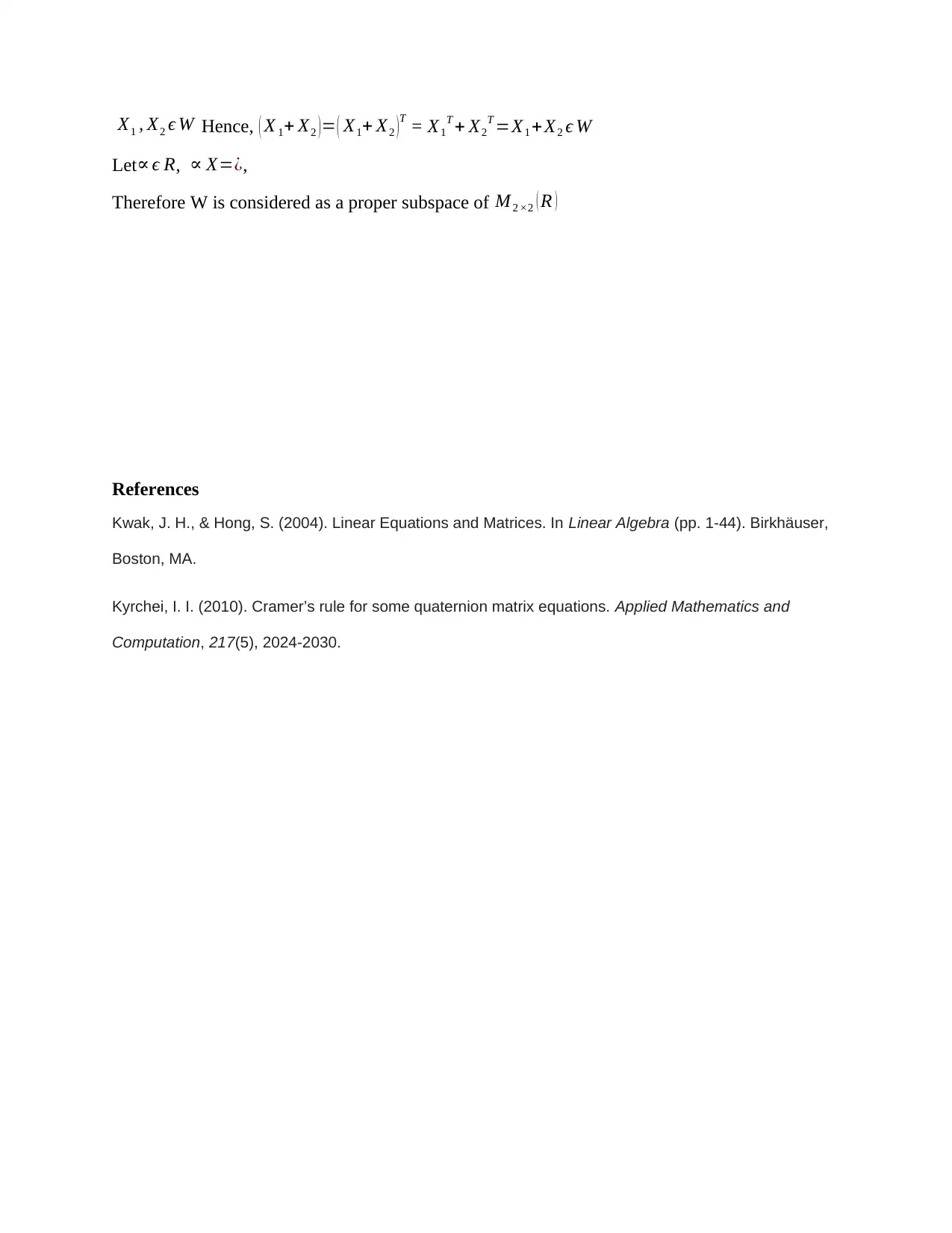
X1 , X2 ϵ W Hence, ( X 1+ X2 ) = ( X1+ X2 )
T = X1
T + X2
T =X1 + X2 ϵ W
Let∝ ϵ R, ∝ X=¿,
Therefore W is considered as a proper subspace of M 2 ×2 ( R )
References
Kwak, J. H., & Hong, S. (2004). Linear Equations and Matrices. In Linear Algebra (pp. 1-44). Birkhäuser,
Boston, MA.
Kyrchei, I. I. (2010). Cramer’s rule for some quaternion matrix equations. Applied Mathematics and
Computation, 217(5), 2024-2030.
T = X1
T + X2
T =X1 + X2 ϵ W
Let∝ ϵ R, ∝ X=¿,
Therefore W is considered as a proper subspace of M 2 ×2 ( R )
References
Kwak, J. H., & Hong, S. (2004). Linear Equations and Matrices. In Linear Algebra (pp. 1-44). Birkhäuser,
Boston, MA.
Kyrchei, I. I. (2010). Cramer’s rule for some quaternion matrix equations. Applied Mathematics and
Computation, 217(5), 2024-2030.
1 out of 8
Related Documents
Your All-in-One AI-Powered Toolkit for Academic Success.
+13062052269
info@desklib.com
Available 24*7 on WhatsApp / Email
![[object Object]](/_next/static/media/star-bottom.7253800d.svg)
Unlock your academic potential
Copyright © 2020–2025 A2Z Services. All Rights Reserved. Developed and managed by ZUCOL.





